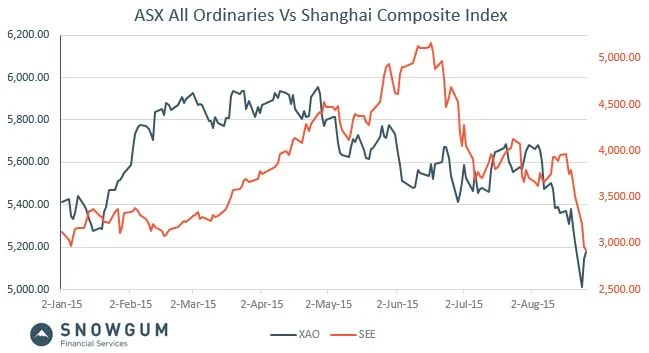The last few weeks have seen investors navigating some pretty turbulent waters. All major markets have fallen sharply following a Chinese stock market bubble bursting, with the ASX all ordinaries bottoming out at a two year low of 4,937.60 on Tuesday the 25th of August.
Some have argued that the catalyst for the collapse in Chinese markets is the result of liquidity pressures from a variety of fronts. The price of oil has continued to weaken resulting in oil producers reducing their equity positions to bridge profit and cash flow shortfalls. In conjunction with oil led external pressure on Chinese markets, internally led pressure from margin calls and automated stop loss trades on ETF exposures proved enough to tip the balance in favour of sellers, triggering a correction in Chinese markets. Not even a Chinese government intervention could right this ship.
The graph below demonstrates the meteoric rise in Chinese asset prices, followed by a meteoric fall.
Where to next
A strong perception of 'fully priced' markets, particularly from money managers, has been the prevailing theme of 2015. In hindsight the recent fall in markets was an inevitable correction towards more reasonable valuation metrics based on fundamentals. Hindsight is always easier to see.
The graph below overlays the ASX All Ordinaries (XAO) against the Shanghai Composite Index (SSE). Although the SSE has been scaled to moderate its volatility in comparison to the XAO, it demonstrates that Australian and Chinese share markets have made a tumultuous return back to earth from their respective 2015 bull runs. Bull runs that weren't reflective of corresponding positive fundamentals.
For investors who have demonstrated patience in waiting for an opportunity to undertake further investing, now represents an opportunity to dip the toes back in the water.
As the Shanghai Composite Index and Chinese markets more broadly edge closer to their pre-bubble metrics, we are unlikely to see the scale of negative China led volatility that has just passed. Closer to home, given that underlying economic conditions remain neutral and the US remains buoyant, the recent ASX pull back sees investment markets for the first time in nearly 12 months get within cooee of their 'fair value'.
Some money managers remain bearish on this view, and in normal circumstances we would agree with them. However, given the prevailing low interest rate environment and a lack of investment alternatives, investing in companies has again emerged as the best prospect for investors searching for returns. The fixed interest asset class remains subdued and domestic property has to be the most widely predicted asset class in recent history to be expected to suffer a negative correction.
When it comes to property, pundits have for years been predicting everything from stagnating growth to bubbles bursting with the fury of a thousand suns. Pundits also happen to have been wrong now for a number of years. When the property market does inevitably regress, it will no doubt result in a lot of well communicated hindsight wisdom.
For those still considering property investment, we believe you need to have a very long time horizon in mind (>7 years as a minimum). When weighing up a property investment, if financing is involved, you should also be incorporating a significant interest rate buffer (i.e. around 3%) in any serviceability calculation. If an additional 3% interest rate makes the financing arrangement infeasible, then it probably is.



